
Princess Peach is a character in Nintendo's Mario franchise. She was created by Shigeru Miyamoto and introduced in the 1985 original Super Mario Bros. game as Princess Toadstool. She is the princess regnant and head of state of the Mushroom Kingdom, where she resides in her castle along with Toads. Since her debut, she has appeared in the majority of Mario video games as the main female character and the romantic interest of Mario. She has been voiced by Samantha Kelly since 2007.
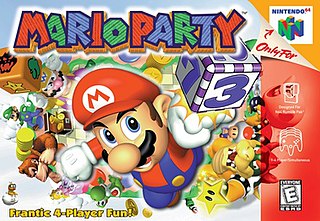
Mario Party is a 1998 party video game developed by Hudson Soft and published by Nintendo for the Nintendo 64. The game was targeted at a young audience. Mario creator Shigeru Miyamoto served as development supervisor. It received mostly positive critical reviews for its multiplayer mode, concept, and music; disapproval of its slow pacing; and mixed reviews of its graphics. It is the first installment in the Mario Party series and was followed by Mario Party 2 in 1999. The game received its first official re-release on the Nintendo Switch Online + Expansion Pack in 2022.

Mario Party 5 is a party video game developed by Hudson Soft and published by Nintendo for the GameCube. It is the fifth installment in the Mario Party series and the second game in the series to be released for the GameCube. It was first released in North America and Japan in November 2003, followed by Europe a month later. The game is set in the fictional Dream Depot, consisting of seven game boards. The single-player "Story" mode involves the player winning multiple games against the Koopa Kids to prevent Bowser from conquering the Dream Depot. The main multiplayer game mode consists of four characters from the Mario series playing a board game, with each board having a set theme. The game also features several minigames, which are played after every set of turns. Mario Party 5 introduces the "Super Duel" mode to the franchise, which requires players to assemble and control custom made battle vehicles which can be used in combat against other machines. The game features ten playable characters, with playable debuts to the series from Toad, Boo, and Koopa Kid.
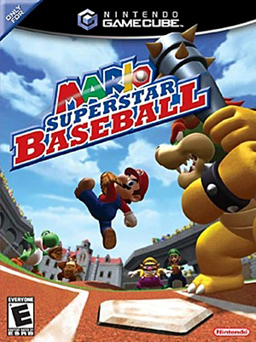
Mario Superstar Baseball is a 2005 sports video game developed by Namco and published by Nintendo for the GameCube. The game was created in the vein of other Mario sports games such as Mario Golf: Toadstool Tour and Mario Power Tennis. A sequel, Mario Super Sluggers, was released for the Wii in 2008.
DDRMAX Dance Dance Revolution 6thMix is the 6th game in the Dance Dance Revolution series of music video games. It was released in the arcades by Konami on October 19, 2001, and for the PlayStation 2 on May 16, 2002, in Japan. 6thMix contains a total of 42 songs, all which made their first arcade appearance on this release. 11 of these songs debuted in various console releases prior to 6thMix. All arcade songs from Dance Dance Revolution to Dance Dance Revolution 5thMix were removed in 6thMix, although many of the Konami originals from those games would later be revived in future arcade releases.
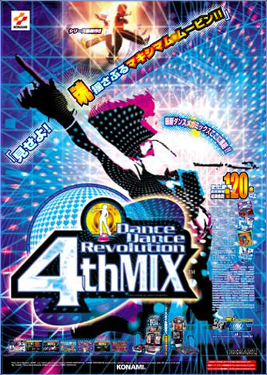
Dance Dance Revolution 4thMix is the fourth game in the main Dance Dance Revolution series of music video games. It was released as an arcade game by Konami on August 24, 2000, in Japan. 4thMix features 136 songs, of which 37 are new songs available and 12 are new unlockables that require an operator code. Dance Dance Revolution 4thMix Plus is an update that unlocks these 12 songs without an operator code, while also adding 14 new songs of its own, for a total of 150 songs.
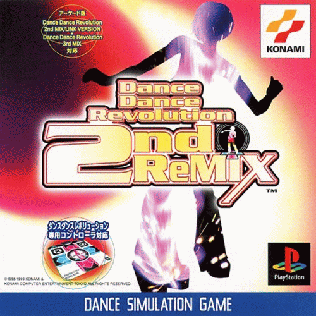
Dance Dance Revolution 2ndMix, sometimes abbreviated as 2ndMix, is the second game in the Dance Dance Revolution series of music video games. It was released as an arcade game by Konami on January 29, 1999. The initial release has a total of 33 songs: 22 brand new songs, and 11 from its predecessor, Dance Dance Revolution.
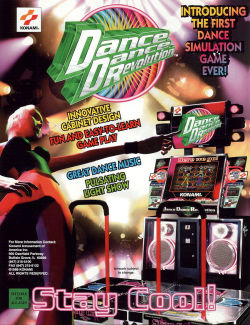
Dance Dance Revolution (DDR) is a music video game, developed by Konami, released in arcades on September 26, 1998, in Japan. Dance Dance Revolution is a unique game involving dance and rhythm that defined the genre. It involves timing and balance by having players use their feet instead of their hands like typical video games. In March 1999, the game was released for North American arcades, and for European arcades under the name Dancing Stage. Players and game critics were caught off-guard by the game's addictive qualities winning the new franchise many merits to its design.

Super Mario is a platform game series created by Nintendo starring their mascot, Mario. It is the central series of the greater Mario franchise. At least one Super Mario game has been released for every major Nintendo video game console. However, there have also been a number of Super Mario video games released on non-Nintendo gaming platforms. There are more than 20 games in the series.

Dance Dance Revolution Hottest Party, known as Dancing Stage Hottest Party in the European and Oceanic regions, is a video game released by Konami in 2007 and 2008 to several countries for the Wii console. Konami took the game beyond the traditional setup of Dance Dance Revolution by incorporating the Wii Remote and the standard dance pad into a full body motion game. It has two sequels, Dance Dance Revolution Hottest Party 2 and Dance Dance Revolution Hottest Party 3.

Dancing Stage featuring Disney's Rave is a music video game released in Japan in arcades on November 30, 2000. On the same day, it was also released for the PlayStation, but under the name Dance Dance Revolution Disney's Rave. It was later released in September 2001 North America as Dance Dance Revolution Disney Mix and in Europe and Australia as Dancing Stage Disney Mix. It is based on Konami's Dance Dance Revolution (DDR) series with animated Disney characters and electronic dance music remixes of past Disney songs. They also include a few non-Disney songs that were popular at the time of the game's release. It is considered to be one of the rarest DDR game released in arcades.
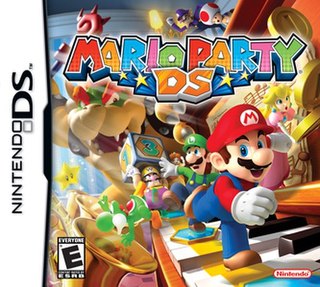
Mario Party DS is a 2007 party video game developed by Hudson Soft and published by Nintendo for the Nintendo DS. It is the second handheld game in the Mario Party series, as well as the last game in the series to be developed by Hudson Soft, as all subsequent titles have been developed by NDcube. The game was later released on the Virtual Console for the Wii U in April 2016.

Dance Dance Revolution Extreme is a music video game by Konami and is the eighth release in the main Dance Dance Revolution (DDR) series. It was released on December 25, 2002, for Japanese arcades, on October 9, 2003, for the Japanese PlayStation 2, and on September 21, 2004, for the North American PlayStation 2. This game is the ninth release in North America, but despite having the same name as its Japanese counterpart, its gameplay and soundtrack is significantly different and won the Video Music Awards in 2005 on MTV for Best Video Game Soundtrack.
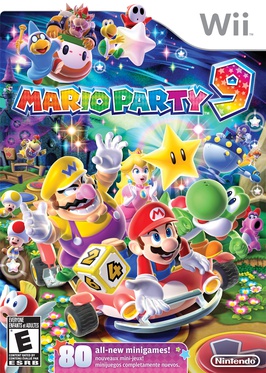
Mario Party 9 is a 2012 party video game developed by NDcube and published by Nintendo for the Wii. The ninth main installment in the Mario Party series, it was announced at E3 2011 and released in Europe, North America, and Australia in March 2012, followed by Japan a month later. It was the first game in the series not to be developed by Hudson Soft, which was acquired and dissolved by Konami on March 1, 2012, the day before the game's European release. Instead, development was taken over by Nintendo studio NDCube. This was also the final Mario game to be released on the Wii.

Toad, known in Japan as Kinopio, is a character from the Mario franchise. The character was created by Japanese video game designer Shigeru Miyamoto, and is portrayed as a citizen of the Mushroom Kingdom and one of Princess Peach's attendants. Toad is typically a non-player character who assists Mario and his friends, but he occasionally appears as a protagonist.
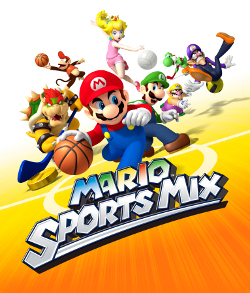
Mario Sports Mix is a sports video game developed by Square Enix and published by Nintendo for the Wii. It was released in Japan on November 25, 2010, and in other regions in early 2011. It features volleyball, ice hockey, dodgeball, and basketball. The game features mostly characters and locations from the Mario series with a few guest appearances by characters from Square Enix's Final Fantasy and Dragon Quest series of games. Players can also opt to play as one of their Mii characters.
Dance Dance Revolution X3 is a music video game, and a part of the Dance Dance Revolution series. The arcade version of DDR X3 was revealed by Konami on June 2, 2011. The sequel to Dance Dance Revolution X2, X3 began public beta testing on June 8, 2011. Promotional information for the game revealed the full name for the game, called Dance Dance Revolution X3 VS 2ndMix due to the new "2ndMix" mode in the game. It was released in Japan on November 16, 2011 for dedicated cabinets and November 30, 2011 for upgrade kits, and December 16, 2011 in Asia.
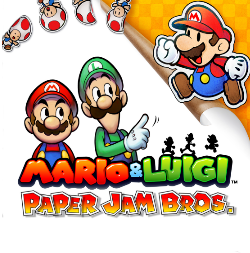
Mario & Luigi: Paper Jam, known in Europe and Australia as Mario & Luigi: Paper Jam Bros., is a 2015 role-playing video game developed by AlphaDream and published by Nintendo for the Nintendo 3DS console. It is the fifth installment in the Mario & Luigi series, and serves as a crossover between the Mario & Luigi and Paper Mario series, the latter being a cross-genre series developed by Intelligent Systems. In Paper Jam, Luigi accidentally opens a book containing the Paper Mario universe, causing all of its contents to spread into the Mushroom Kingdom; Mario and Luigi, with the help of the befriended Paper Mario, venture to save both Princess Peach universe variants from Bowser, who has teamed up with his paper counterpart as well. In the game, the player controls the trio simultaneously through an overworld to reach Bowser's Castle, and fights enemies in turn-based combat along the way.

Mini Mario & Friends: Amiibo Challenge is a 2016 puzzle-platform game developed and published by Nintendo for the Nintendo 3DS and Wii U. The seventh entry in the Mario vs. Donkey Kong series, the game was free to download on the Nintendo eShop, but requires Nintendo's Amiibo lineup in order to play. It was released in Japan in January 2016 and worldwide in April.

















